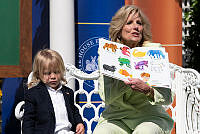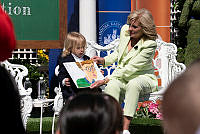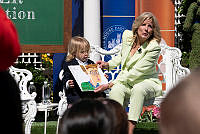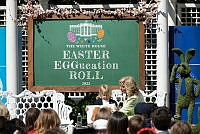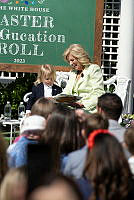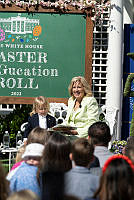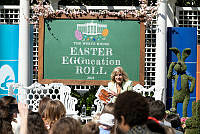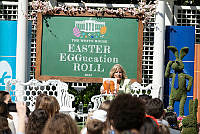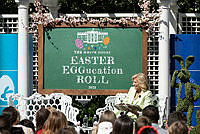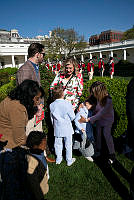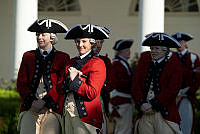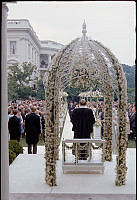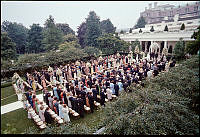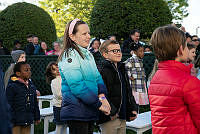First Lady Helen Taft's Luneta
Remembered in Washington's Potomac Park
Copyright © September 01, 2013 White House Historical Association. All rights reserved under international copyright conventions. No part of this article may be reproduced or utilized in any form or by any means, electronic or mechanical, including photocopying, recording, or by any information storage and retrieval system, without permission in writing from the publisher. Requests for reprint permissions should be addressed to books@whha.org
“That Manila could lend anything to Washington may be an idea that would surprise some persons, but the Luneta is an institution whose usefulness to society in the Philippine capital is not to be overestimated.”
–Helen Herron Taft
In her memoirs, Recollections of Full Years, Helen Herron Taft wrote about a promenade by the Manila Bay that inspired the first public project spearheaded by a first lady.1 She had her eye on the reclaimed expanse of land by the Washington Monument, established by Congress in 1897 as Potomac Park, a public recreation space.2 During those early days of the automobile, President William Howard Taft and the first lady were among those who enjoyed cruising along the “Potomac Speedway,” a road strip running along the northern border of the new park. But more than just a place for joyrides, Helen Taft had a vision for Potomac Park, as “a glorified Luneta where all Washington could meet, either on foot or in vehicles, at five o’clock on certain evenings, listen to band concerts and enjoy such recreation as no other spot in Washington could afford.”3
Helen Taft was recalling the years she spent in the Philippines from 1900 to 1903, when her husband was civil governor of the East Asian archipelago that had become a United States colony or protectorate after the Spanish-American War of 1898. It was during this time that, as “first lady” of the Philippines, Mrs. Taft became acquainted with the Luneta, a public park that was part of the fabric of Manila’s social life and the setting of pivotal events in Philippine history.

Carriages line the seaside promenade of the Luneta, early twentieth century. The bandstand is visible on the left.
Library of CongressThe Spanish Luneta
The city of “Maynila” on Luzon, the biggest island in the Philippines, was settled and ruled by Muslim chiefs before the arrival of the Spanish conquistadors in the sixteenth century. It was a palisaded kingdom, strategically harbored on the Manila Bay, which opens to the China Sea. In 1571, Miguel López de Legazpi and his contingent overcame the forces of Rajah Sulayman, the local chief, and claimed Manila for the Spanish Crown. In medieval tradition, walls were built to enclose the city, and a moat was dug around it. The walled city, Intramuros, was roughly triangular in shape, bordered on the west by the bay, on the north by the Pasig River, and by the adjacent land to the east and south.4 Displaced natives occupied the territory outside the walls. The land immediately to the south of Intramuros was called Bagumbayan in the native Tagalog dialect, meaning “New Town.” It became the site of a lunette, a crescent-shaped fort detached from the city’s primary defenses. In the early 1800s, the park created on the beachfront of Bagumbayan took its name from the demilune structure and was called the Paseo de Luneta or, simply, the Luneta.5
David Prescott Barrows, head of education in the Philippines from 1900 to 1909, wrote one of the earliest English-language histories of the country. In seventeenth-century Spanish records he found mention of an open area of recreation extending “for about a league along the sea and through the street and village of natives called Bagumbayan” that he believed to be a reference to the Malecon and the Luneta.6 The Malecon Drive, an esplanade immediately outside the west wall of Intramuros, ran parallel to the Manila Bay and at its southern end opened into a formal plaza, the Luneta. At the turn of the century, they were the preeminent leisure spots in Manila.
Joseph Earle Stevens, a businessman who spent time in the Philippines from 1894 to 1896, vividly recounted the social ritual that took place during the Spanish regime at:
"the far-famed seaside promenade called the Luneta, where society takes its airing after the heat of the day is over. Imagine an elliptical plaza, about a thousand feet long, situated just above the low beach which borders the bay. . . . In the centre of the raised ellipse is the band-stand, and on every afternoon, from six to eight, all Manila come here to feel the breeze, hear the music, and see their neighbors. Hundreds of carriages line the roadways, and mounted police keep them in proper file. The movement is from right to left, and only the Archbishop and the Governor-General are allowed to drive in the opposite direction."7

This colorized photograph (above and below) from about 1901 offers a sweeping view of the Luneta on Manila Bay. The lamps were first fitted with electric lights in 1895, near the end of the Spanish colonial era. In 1903, an American investor organized the Manila Electric Railroad and Light Company to build an electric tram in the city. Meralco, as it is still known by acronym to this day, is the largest utility company in the Philippines.
Library of Congress
The Spanish Luneta was not purely a pleasure ground, however. It was also a killing field. The authorities made examples of insurgents and public offenders by meting out capital punishment in a public venue. In 1872, a small and easily quelled uprising in the province of Cavite provided the excuse the government needed to arrest several citizens suspected of activism. Among them were three priests—Mariano Gómez, José Burgos, and Jacinto Zamora. Their brutal killing by garrote in the Luneta is considered by many Filipino historians to be a critical moment in the birth of nationalism.8
Firing squads were advertised as festive spectacles, to be accompanied by music. The condemned were often shot in the morning, facing the rifles with their backs to the beach.9
But undoubtedly the most significant execution at the Luneta is that of José Rizal, the ilustrado (a well-educated, upperclass Filipino) whose polemical writings about the abuses of the Spanish friars inspired a generation of patriots. He was convicted in a sham trial and incarcerated at Fort Santiago, the prison at the northern tip of Intramuros. In his two most famous novels, Noli Me Tangere (1887) and El Filibusterismo (1891), the Luneta and Malecon figure prominently as the setting for leisurely carriage rides, romantic trysts, and musical performances. In a bittersweet touch of irony, he was marched down that very drive and was shot in the storied plaza on December 30, 1896.
Rizal’s execution proved to be a turning point in the revolution. Two years later, the Filipino rebels gained enough ground to declare independence and promulgate the country’s first constitution in January 1899. It was to be a short-lived liberation. The Treaty of Paris, signed a month before, ceded the Philippines to the United States for its victory in the Spanish-American War. American military forces moved into Manila against an underpowered but vociferous Filipino resistance. In 1900, President William McKinley made William Howard Taft head of the Philippine Commission to transition the country to civilian rule and prepare the Filipinos for self-governance.
The American Luneta
Helen Taft, her sister, and her three children arrived in Manila in August 1900. Her husband, who had been there two months prior, had rented a house for his family in Malate, a posh suburb south of the walled city. On the way there, he stopped and pointed out the “famous Luneta” to his wife. She was unimpressed. “An oval drive, with a bandstand inside at either end,—not unlike a half-mile race track,—in an open space on the bay shore; glaringly open. Not a tree; not a sprig of anything except a few patches of unhappy looking grass.”10 She would later acquire a different perspective.
Other writers from the post-Spanish period likewise suggest that the Luneta had seen better days. Burton Holmes, a travel writer who went to Manila shortly after the American occupation, writes thus:
"The Luneta cannot be called either beautiful or picturesque, and save at the fashionable driving hour, when the band is playing and the driveway thronged, it presents a sadly desolate appearance. . . . In Spanish days it was far more attractive; but the trees have been cut down, the glass globes on the lamp-posts shattered, and four cold electric lights replace the softer, warmer glare of the hundred blazing wicks."11
Despite its stark visage, the Luneta continued to be the fashionable gathering place. Travel accounts from the early twentieth century paint a gay picture of the afternoon pageant:
"Luneta at evening presents a panorama which one may see nowhere else in the world. Thousands of people every evening drive upon the boulevard in their carromatas, or two-wheeled covered buggies, drawn by Filipino ponies.12
"We halted to hear some jolly tunes played by the band on the Luneta. Again there was the blue dusk; the orange and saffron horizon; and the moving crowds in white on the bright green grass plots round the bandstand."13

Helen Taft in traditional Philippine costume, c. 1901–03.
Library of CongressThe Luneta became a regular part of Helen Taft’s social calendar in Manila. She outfitted her coachman in smart livery for their trips to the park where “we were sure to see everybody we knew and hundreds of people besides.” She wrote about official events held there, such as a grand celebration of George Washington’s birthday. Her recollections took on an especially tender tone on the subject of her children. “They lived out of doors and did everything that children usually do, but their most conspicuous performance was on the Luneta in the evenings, where they would race around the drive on their little ponies . . . or play games on the little grass plots which were . . . maintained chiefly for the benefit of children, both brown and white.”14 The last passage is one of several references she made to the racial diversity of her Manila circle, from the guests she invited to Malacañang Palace (the governor’s residence) to her children’s playmates.
Bernard Moses, a professor from the University of California, was another member of the Philippine Commission. His wife, Edith, published her own journal of their time in the Philippines, Unofficial Letters of an Official’s Wife (1908). She makes frequent mention of people-watching on the Luneta and racing up and down the Malecon. “I can understand why everyone goes to the Luneta in the evening. There is always a breeze and there are no mosquitoes; besides that, one meets everyone he knows, and ladies visit in each other’s carriages in an informal way.”15
The economic expansion of the nineteenth century had created social mobility among the classes, and observations about the Luneta crowd allude to it. John Bancroft Devins, editor of the New York Observer, noted during his visit in 1898, “American, Spaniards, Filipinos, Chinese meet here, the turnouts of some of the brown and yellow people not a whit behind in style or expense those carrying paler faces.”16 The bourgeois preoccupation with display and appearance trickled down to Edith Moses’s poor neighbors across the street. They lived in a nipa hut (a shack made of palm leaves and bamboo) but nevertheless donned their finest clothes and hired a ride three times a week on the Luneta.17
Some writers likened the daily theater on the plaza to a farce, hinting at a postwar loneliness and disillusionment behind the mask of conviviality. Holmes’s depiction of wounded American soldiers making the daily march to the Luneta is tinged with bitterness: “Hither they come, a motley, weary, ragged throng, with faces haggard . . . they sit on the stone benches or on the mossy curb and listen to the music, and gaze seaward at the transports, wondering when their turn to sail away will come.” For him, the brief moment of wistfulness is over when the music stops, the crowd disperses, and “the sun drops like a ball of fire into the China Sea and another day of work and suffering in the Philippines is ended.”18
William Howard Taft’s tenure as civil governor of the Philippines ended in 1904. He returned as President Theodore Roosevelt’s secretary of war, leading a diplomatic expedition to Asia that called on Japan, the Philippines, and China in the summer of 1905. The high-profile entourage aboard the SS Manchuria included Alice Roosevelt, the president’s 21 year old daughter. She was fashionable, outspoken, and dubbed “Princess Alice” by the press, and her presence overshadowed the pioneering political mission of the tour. Wishing to avoid the media frenzy, Helen Taft opted for a quiet vacation in England with her children and friends. She wryly observed that they did not escape the sensationalized accounts of Miss Roosevelt’s adventures in the Far East reported in the British and American newspapers.19 She nevertheless looked forward to traveling back to the Philippines for the inauguration of the Philippine Assemble, the country’s first legislative body. She and Secretary Taft did attend as honored guests of the Filipino people and Civil Governor James Smith in 1907. In 1908 William Howard Taft was elected president of the United States.
Mrs. Taft’s acquisitions from her world travels included art, furnishings, clothing, and other souvenirs. Among the most visible mementos from the Orient were a tapestry (a gift from the empress of Japan), which she hung in the State Dining Room of the White House, and an ornately carved narra (Philippine mahogany) bed, which was installed in the bedroom of the Taft home in New Haven, Connecticut. But perhaps more enduring were the memories of the leisurely lifestyle she enjoyed so much in the Tropics. Her garden parties, lush with potted palms and aglow with illuminated trees, were a nostalgic reference to her Malacañang soirees and became a signature style of entertaining.20

The Malecon Drive ran parallel to the Manila Bay, opening at its southern end to the Luneta, early twentieth century.
White House Historical AssociationThe Luneta on the Potomac
President Taft and First Lady Taft shared a love of music and spent many evenings in the Blue Room listening to records on the Victrola, looking out on the South Lawn with its view of the Washington Monument. One can imagine how cool breezes from the nearby Potomac would have stirred up fond memories of balmy nights on the veranda of Malacañang, the mansion that overlooked the Pasig River. When she and the president raced down the Speedway, the wind in her face would have taken her back to refreshing afternoon rides at the Luneta. She says as much in her memoirs: “For a long time before Mr. Taft became president I had looked with ambitious designs upon the similar possibilities presented in the drives, the river-cooled air and the green swards of Potomac Park.”21
But beyond the suggestion of the topography, Helen Taft wanted to establish a social atmosphere. In her first spring as first lady she had the Speedway renamed Potomac Drive. She selected a site for a bandstand and arranged for an inaugural event to formally open the park on April 17, 1909. Appropriately, among the performers featured was the Philippine Constabulary Band, an acclaimed musical ensemble formed in 1902 by Walter Loving, an African American military officer stationed in the Philippines. The band had previously played at William Howard Taft’s presidential inauguration and at the 1904 World’s Fair. That Saturday afternoon, President and Mrs. Taft drove up in their landaulet to join the throng of people who had come to catch a glimpse of the first couple, to mingle and listen to music. The event was a resounding success. Potomac Park became the city’s most fashionable afternoon spot from April to late October.22 Helen Taft had created her own Luneta in Washington, D.C.

This period postcard depicts the Potomac Speedway, a strip of road along the northern border of Potomac Park.
White House Historical AssociationA Gift of Trees
On her way to the Philippines in 1900, Mrs. Taft traveled to Japan and was charmed by the beauty of the flowering cherry trees. There she met Catherine Scidmore, mother of an American diplomatic officer and the doyenne of Japanese foreign society. Mrs. Taft wrote admiringly of her sense of style, youthful energy, and sharp intellect, and noted that her daughter Eliza was a well-known travel writer of East Asia.23 The acquaintance would foreshadow a historic collaboration. Nine years later, Eliza Scidmore wrote First Lady Helen Taft, suggesting that Japanese cherry trees be planted along the Tidal Basin. This idea was supported by David Fairchild, a botanist at the Department of Agriculture who had imported trees from Japan and planted them with success on his own property.
Mrs. Taft began to request that all the flowering cherry trees in the country’s nurseries be set aside for planting in Potomac Park. The Japanese consul in New York, upon hearing about the request, offered a gift of 2,000 trees from the city of Tokyo. These arrived in January 1910 but, to everyone’s dismay, were discovered to be pest ridden and diseased, and were burned. The mayor of Tokyo sought to make amends by offering a second donation, this time increasing the number of trees to 3,020. Two years later, the shipment arrived in Washington, D.C., and on March 27, 1912, First Lady Helen Taft and Viscountess Chinda, wife of the Japanese ambassador, planted the first cherry trees on the northern bank of the Tidal Basin. A hundred years hence, those two trees still stand in the original location, approximately 125 feet south of what is now Independence Avenue SW.
Helen Taft expressed a desire to have a Japanese cherry blossom season in Potomac Park.24 That wish is fulfilled every spring, as crowds flock to the capital city to witness their spectacular show. The pink and white canopy of blooms and the graceful tree limbs bowing over the water’s edge transform the promenade into a tableau reminiscent of Japanese landscape painting. Next to the White House and the Capitol, the most iconic image of Washington, D.C., is of the flowering cherry trees by the Tidal Basin.

This is a colorized photograph of the blooming cherry trees, c. 1920.
Library of CongressSunset on the Luneta
Potomac Park, as Helen Taft envisioned it, has evolved with time. Technology, modern ideas, a new social order, and the changing roles of men and women have redefined the rituals for meeting and greeting and generated new leisurely pursuits. Runners, joggers, and bikers have replaced the fashionably dressed strollers. Music still plays, but mostly on personal listening devices, attached to individual earphones. People still come to be seen, but mostly to have someone else capture their image in photographs. The scenic view of the trees and the water remains an attraction, along with the many memorials located in the park.
The Luneta has changed as well. In 1904, the United States government sent noted Chicago architect Daniel Burnham to the Philippines to create a plan for Manila, intended to be the flagship American city in East Asia. He filled the moats around Intramuros for sanitation purposes but, in a respectful nod to the Spanish colonial heritage, decided to leave the walled city intact. Burnham and his assistant, William Parsons, drew plans that detailed a grand municipal center composed of Beaux-Arts buildings, wide plazas, and boulevards. The imposing complex would be arranged in an arc around a central lawn, facing the Manila Bay, with an expanded Luneta anchoring the water’s edge.25 Its design drew from the neoclassical vocabulary of Burnham’s White City for the 1893 Columbian Exposition and his ideas for the National Mall, implemented in the McMillan plan of 1902. Political issues and economic concerns derailed the implementation of this American blueprint for Manila. Only three buildings were realized, and today they house the Department of Tourism, Museum of the Filipino People, and National Museum. Built in the Beaux-Arts style by U.S.-trained Filipino architects, they are among the few remnants of Burnham’s City Beautiful vision in East Asia.
In 1913, a monument to honor José Rizal, recognized as a national hero shortly after his death, was erected in the Luneta, and the park was renamed for him. Rizal Park included the old Luneta, expanded toward the south and east, and extended through reclamation toward the bay. Far from the barren promenade that Helen Taft first saw, it now houses Japanese and Chinese gardens, an orchidarium, an amphitheater, and several monuments. Restaurants, a marine theme resort, a shopping complex, and small street vendors draw commercial traffic to the area. The amphitheater hosts free concerts, and, for a fee, the more nostalgic can ride around the park in a horse-drawn calesa. Casual dates and family picnics have replaced the controlled spectacle of nineteenth-century social pleasantries. Tai chi practitioners are a regular sight in the early morning. The park remains a staple venue for political rallies and public celebrations.
Philippine landscape architects, city planners, and historic preservationists have railed against the discordant array of structures that have mushroomed over the years in Rizal Park. Several were built without a regard for axial symmetry or aesthetic harmony and interrupt desirable sight lines afforded by the natural landscape and historic architecture. Beleaguered by bureaucratic obstacles not unlike those that faced the planners a century ago, advocates for renovation are turning to education and digital media to gain support for their ideas. In an emerging culture of national heritage awareness, there is reason to be hopeful that the story of the Luneta will continue to be written. For now, afternoon breezes from the bay still cool the shrinking open spaces. The sunsets are no less spectacular. The park remains egalitarian—open to people from all races and social and economic classes. In contemporary Filipino culture, it is immortalized in a popular song about the memory of a past love, recalling the days of a couple wandering happily about the Luneta, with nary a centavo or a care. The lyrics are unapologetically corny but have remained a local favorite. The Luneta, just like the song, endures.














